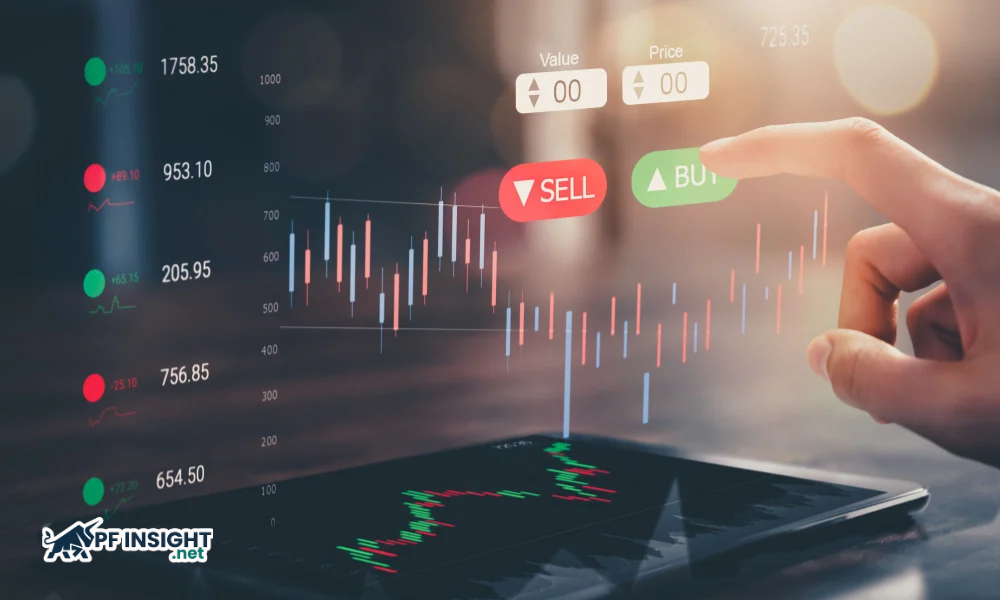Spot trading is a form of buying and selling assets immediately at the current market price. This form provides high liquidity, helping investors react quickly to price fluctuations, but also has many potential risks if there is no effective management strategy. This article will analyze in detail how spot trading works and important notes to help minimize risks for investors.
- Profit taking strategy – How to know the right time to lock in your gains?
- Prop firm trading halal explained: Key points Muslim traders should know
- What is metal trading and when does it make sense to invest?
What is spot trading?
Spot trading, also known as spot trade, is a form of buying and selling of assets such as foreign currencies, commodities or stocks based on the current market price. The goal of this form is to complete the transfer of assets in a short time, usually no more than two business days.
Spot trading is popular with many traders, especially day traders, because it allows for quick opening and closing of orders, takes advantage of small price spreads, and is not bound by fixed contract terms or expiration dates.
Spot traders typically seek to profit by buying assets at low prices in the hope that prices will rise in the future. When the market moves in their favor, they sell to capture the difference in profits. Spot traders can also short sell, which means selling first and buying back later when the price falls to maximize profits from price fluctuations.
How the spot market works

Spot trading works on the following mechanism:
- Transaction process: In spot trading, two parties enter into an agreement to buy or sell an asset based on the current market price. This price directly reflects the fluctuations in supply and demand. Once an agreement is reached, the exchange and payment are made quickly, usually within two business days.
- Participants in the transaction: The spot market includes many different groups of entities such as individual traders, banks, investment funds and large financial institutions. They conduct transactions through centralized exchanges and decentralized markets (OTC), where the parties trade directly with each other without the need for an intermediary exchange.
- Leverage and margin requirements: Spot trading requires investors to pay the full value of the asset immediately upon execution of the order. However, in some markets, traders can use margin – that is, borrow additional capital to open a position larger than the amount they own. Using this leverage can magnify profits, but also increases the risk of losing more than the initial investment.
- Where to trade: Spot trading can be conducted on official exchanges or in the over-the-counter (OTC) market. On exchanges, buy and sell orders are matched automatically through an electronic order book system.
Classification of spot trading types
Trading types in the spot market are divided based on the time and method of order execution, reflecting the speed of matching and completing transactions between buyers and sellers on the exchange.
- TOD transaction comes from today: This type of transaction is performed with payment and asset transfer completed on the same day of transaction.
- TOM transaction is short for tomorrow: This form requires the transfer of assets and completion of payment to take place on the same trading day.
- SPT transaction comes from the spot: This form is implemented with the payment and asset transfer process completed after 2 business days from the time of placing the buy or sell order.
Note: All transaction deadlines are calculated in business days. This rule is especially important when performing TOM or SPT transactions on Fridays, as the settlement date will be moved to the beginning of the following week.
Types of spot markets
In general, investors can conduct spot trading on two main types of markets: decentralized (OTC) markets and globally renowned centralized exchanges.

OTC Markets
OTC trading is a form of buying and selling financial assets and securities conducted directly between participating parties such as brokers, agents or traders. Simply put, OTC transactions do not take place on a centralized exchange but through a system connecting brokers and agents. In addition, the OTC market is more flexible by allowing parties to negotiate specific terms, including different contract sizes, to suit the needs and capabilities of each investor.
In short, since the market is not supervised by a central authority, participants may face credit risk from their counterparties. In this model, brokers, also known as market makers, buy and sell financial assets directly from their own portfolios.
Market exchanges
The centralized exchange is responsible for organizing and supervising the buying and selling of assets such as foreign exchange, commodities or cryptocurrencies. This is the place that plays the role of a bridge between investors and asset custody organizations. When participating in transactions on this exchange, users need to deposit fiat money or cryptocurrencies into their accounts to be able to execute buying and selling orders.
The world’s leading stock exchanges include major markets such as the US NYSE and Nasdaq, along with other international exchanges such as London (LSE), Shanghai (SSE) and Hong Kong (HKSE). These exchanges allow investors to conduct spot trading, allowing for quick and direct transfers of assets and payments.
Detailed instructions on how to do spot trading
Spot trading allows investors to buy and sell assets immediately at current market prices. Below are 6 simple steps to help newbies access this form of trading easily, effectively and safely in investment.

Step 1: Learn about the different types of financial instruments
Learning about financial instruments is an important step to improve investment knowledge and risk management in spot trading. These instruments include stocks, bonds, futures, options and other derivative products, each with its own characteristics, risk levels and profits. Understanding the operating mechanism of each instrument helps investors choose the right strategy, optimize profits and protect capital effectively.
Step 2: Choose the spot market
The spot market is where currency pairs are bought and sold directly at current prices, unlike futures or Forex options. When choosing to trade Forex on the spot market, you need to understand the payment mechanism, standard settlement times and how prices are determined. Understanding these factors will help you make accurate trading decisions, reduce risks and optimize profits.
Step 3: Choose the right broker and open an account
Do your research and choose a reputable Forex broker that suits your trading style and strategy. Carefully evaluate factors such as spreads, transaction fees, and additional services before making a decision. Once you have identified a good broker, you can proceed to register and open a trading account to start participating in spot trading.
Step 4: Build a trading strategy
Develop a spot trading plan that includes a specific strategy, profit targets, and personal risk limits. This plan should be compatible with the conditions of the spot market. Additionally, you should determine and adhere to your desired spread when making trades. After studying the market trend, look for the optimal entry point: Buy when the market is growing (uptrend) or sell when the market is declining (downtrend). Utilizing technical analysis indicators and signals will help you track current market movements and predict upcoming fluctuations.
Step 5: Start placing orders
Once you have identified the financial instrument you want to trade, you execute a buy order immediately at the current market price.
- Using stop and limit orders helps manage risk effectively, predetermine the maximum loss you can accept, ensuring each trade does not exceed the set safety limit.
- Always monitor spot trading and price movements continuously. Apply technical indicators to analyze future trends. Exit when the market moves against your strategy and only enter when the price movement is in line with your intended direction.
Step 6: Close the transaction
You can close your positions on the spot market the same day to avoid being charged overnight fees. When you see an asset making a profit during the session, taking profits quickly can help protect short-term profits and reduce the risk of unexpected price fluctuations.
10 spot trading strategies to increase profits quickly
To perform spot trading effectively, you can refer to the following trading strategies:

Scalping
Scalping is a fast trading strategy, opening and closing orders within minutes or seconds, aiming to make small profits from each price movement. This method requires a liquid market and the trader’s ability to react quickly to take advantage of even the smallest opportunity. To be successful with this method, traders need to execute orders quickly, take advantage of small price spreads and limit slippage. The strategy requires maximum concentration and is most effective in highly volatile markets such as Forex and cryptocurrencies.
Tip: Scalping strategies work best when the market is highly liquid, especially during the intersection of major sessions such as London and New York. To maximize the opportunity, traders should use platforms with fast and stable order processing speeds.
Momentum trading
Momentum trading focuses on exploiting the strength of a clear trend, whether up or down. Traders will buy when prices are moving up and sell when prices are moving down, based on the likelihood of the trend continuing. Tools such as MACD and RSI help assess market momentum, supporting more accurate entry and exit decisions.
Tip: Close your position as soon as you see a price pause or technical indicators show the market is overbought or oversold, to secure profits before the trend reverses.
Range trading
During periods of market stability, lacking a clear trend, range trading strategies are effective. Investors will buy at support levels (low prices) and sell at resistance levels (high prices), based on the expectation that prices will remain within the set range.
Tip: Use the RSI indicator in spot trading to detect overbought points near resistance, or oversold points near support levels, for more accurate entry and exit.
Breakout trading
Breakout traders often do well when prices break out of a sideways range. They patiently wait for prices to break above resistance or below support, which signals the start of a new market trend.
Tip: Pay close attention to trading volume, breakouts with high volume are usually more reliable, signaling strong market participation and a high probability of success.
Swing trading
Swing trading exploits price changes that last from a few days to a few weeks, aiming to profit from short- or medium-term trends. Spot traders often use technical indicators and trend analysis to look for entry points where the market is expected to “move” in a favorable direction.
Tip: Combine technical analysis like chart patterns, trend lines with market news to determine optimal trading times and maximize profits.
Day trading
Day traders open and close positions during the trading session, avoiding potential overnight risks. By using short timeframe charts such as 5-minute or 15-minute charts, they seek to profit from the small, rapid price movements that occur throughout the day.
Tip: When participating in spot trading, you should prioritize highly liquid assets with large daily price fluctuations to ensure there are always many opportunities to trade.
Trend following
This method requires traders to follow the prevailing market trend. They will buy when the market is trending up and sell when the market is trending down. To reinforce their belief in the strength of the trend, they often rely on technical indicators such as moving averages.
Tip: The 200-day Moving Average is a reliable tool for determining long-term trends. Prices above this line signal an uptrend and below it indicate a downtrend.
Reversal trading
Traders often focus on spotting potential turning points in the market. They watch for signals that warn of a trend change and use tools like RSI or Bollinger Bands to predict and take advantage of opportunities before the market actually turns.
Tip: When spot trading, strengthen your analysis by combining multiple reversal signals such as price-RSI divergence or Doji, Hammer candlestick patterns to confirm trend changes.
Fibonacci retracement
The Fibonacci retracement tool helps traders identify areas where the trend may reverse during a price correction. By applying important Fibonacci ratios such as 38.2%, 50%, 61.8%, traders can place orders appropriately to take advantage of potential market turning points.
Tip: Using Fibonacci with other indicators such as EMA or trendline helps you confirm signals, improve accuracy and give you more confidence when making trading decisions.
News based trading
This strategy requires traders to react quickly to important market-moving information, such as earnings reports or major economic data releases. The goal is to enter trades immediately after high-impact events, which often cause sudden and sharp price movements.
Tip: Keep an eye on the economic calendar and be ready to trade as soon as the news is released. Exit quickly as market reactions are often very fast and strong.
Effective tips for traders to perform spot trading

To perform spot trading effectively, you need to pay attention to the following factors:
- Market research: It is important to do thorough research on the asset you intend to invest in, including its fundamentals, to spot trade successfully. Understand the nature of the asset, its technical mechanism, the players involved in its production, and the actual market demand.
- Develop an entry/exit strategy: It is important to have a clear entry/exit plan when spot trading. You must pre-determine the price levels or technical signals that will be used to open and close the position (e.g., MA crossover or trend line breakout). Sticking to a defined strategy will help you avoid emotional decisions and significantly reduce your trading risk.
- Risk control: When participating in spot trading, the basic rule is to never risk more money than you can afford to lose. Manage your risk by limiting the maximum percentage of capital you are willing to lose on each trade. At the same time, diversify your portfolio by spreading your trades across different asset classes instead of focusing on a single market. This ensures long-term security.
- Follow news, events: Constantly monitoring market trends and relevant events helps traders to know which assets are gaining more interest or facing new issues. Keeping abreast of broader movements and news will go a long way in helping you become a successful spot trader.
- Maintain discipline and control your emotions: Relying on emotions like fear or greed to trade is an unwise decision. It is best for traders to have a plan and stick to it, avoiding the pursuit of quick profits. Discipline requires you to trade calmly, not overreacting to every price change. Controlling your emotions to make informed decisions will ensure your trades are consistent.
Conclude
In short, spot trading offers investors the opportunity to trade quickly and flexibly thanks to the ability to buy and sell assets immediately. However, to be successful, traders need to master market analysis, manage risks effectively and always monitor price fluctuations. This is the key to maximizing the benefits of spot trading. To update more new knowledge, you can visit PF Insight.







